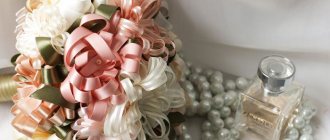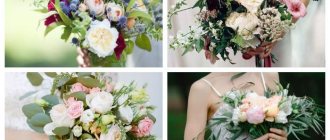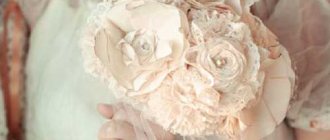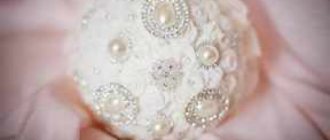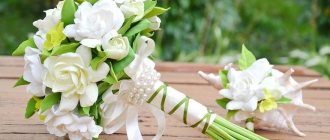It is impossible to imagine a bride at a wedding without flowers. The bride's bouquet is probably one of the most important accessories of her wedding dress. Even at weddings organized in “heavy” thematic styles (urban chic, biker wedding, gothic), the bride holds a bouquet in her hands that matches the wedding style. There are many options for its design, because the art of floristry has been formed over the centuries. One of them is a bridal bouquet on a porta bouquet.
A porte-bouquet (French porte-bouquet) is essentially a small flower vase-holder that looks like a microphone, with a floral sponge inside. The task of the porta bouquet holder is to ensure the convenience of carrying a bouquet and the long-term preservation of flowers. However, it should be taken into account that the design option in a portbouquet, just like “on its own legs,” has certain pros and cons.
How convenient is the accessory?
A bouquet holder is a plastic frame to which living plants are attached. It is shaped like a microphone. Inside the plastic base there is a floral sponge. A damp sponge nourishes the plants. Thus, the bride’s bouquet on the porta bouquet remains fresh for a long time. This is especially important for quickly fading flowers.
In addition to practical, the plastic frame also performs an aesthetic function. It helps create a perfectly smooth round accessory. Without a holder it is impossible to assemble some types of compositions. For example, a cascading bouquet without a base holder is too heavy and uncomfortable for the bride. As a result, a porta bouquet maker helps plants stay fresh longer and makes complex bouquet options possible.
Bridal bouquet of roses - master class
To make such a composition, take:
Using a knife, you need to clear the stems of leaves and thorns. Cut them so that they are equal in length to the handle of the portaquet holder.
Place double-sided tape on the handle of the bouquet and attach the stems here. Place the next row of stems on the table and secure them in this position with ordinary tape.
Cover the top of the bouquet with double-sided tape and glue the roses here, placing the next row in a checkerboard pattern.
Now place the prepared stems on the “leg” of this device and glue them here with tape.
Wrap the resulting leg with a wide satin ribbon and tie a bow.
Dip a floral sponge, called an oasis, into water to saturate the element. Now you can insert the sponge into the hole prepared for it and cover it with a plastic semicircle on top.
Cut the buds, leaving a 5 cm long stem on each. Stick them into the oasis, starting from the middle.
When there are enough roses, stick gypsophila into the sponge.
This is what a beautiful bride's bouquet, created with your own hands, can turn out to be.
Ranunculus look like little roses, so these flowers go together wonderfully. See how to make this type of bridal bouquet.
For now we will only need the blossomed ranunculus buds. They need to be placed in water so that they are saturated with it.
Do not throw away the stems, string them on a wire.
Take a eucalyptus branch, attach a rhododendron and a whole ranunculus flower to it. Attach three roses to this base. Then add the rest of the flowers. Wrap the stems with tape, and attach a decorative ribbon on top of it and secure its ends with pins.
You will get a wonderful bouquet for the bride from roses and other flowers.
Speaking about how to make a bouquet for the bride from peonies, it should be noted that there are varieties of roses similar to these flowers. Look how harmonious the next bridal bouquet looks.
How a composition is created
A floral sponge is a porous material that is saturated with water. The buds, which are then stuck into the sponge, receive the necessary nutrition. Therefore, a wedding bouquet in a porta bouquet holder is convenient for long outdoor events.
Interesting! Still haven't decided which wedding bouquet to choose? This article will help you decide.
Long stems of flowers are cut and inserted into a sponge. The bouquet holder helps create various compositions, so even a beginner can handle assembling the round accessory. You can remove the bud at any time and correct any imperfections.
The handle of the workpiece must be decorated with cord or ribbon. The color and texture of decorative elements are chosen in accordance with the style of the composition. To prevent the hand from slipping along the handle, florists use a combination of smooth and fleecy ribbons.
Advantages and disadvantages of fresh flowers
Modern brides often use artificial elements to compose a wedding bouquet, be it fabric, corrugated paper, ribbons, jewelry, beads, plastic imitations, soft toys, etc. However, fresh flowers still occupy a leading position when choosing elements of a bridal bouquet, this is facilitated by their the following advantages:
- look natural and relaxed; no material can accurately convey such an effect;
- are a classic option that supports old traditions;
- they emit a pleasant aroma that will help the bride feel confident throughout the wedding celebration;
- it doesn’t take much time to make a bouquet;
- emphasize the fragility and femininity of the bride;
- some flowers can be purchased at a low price from gardeners or even grown independently on your own plot;
- fit into the overall decoration of the wedding if flower bouquets are used in it.
Despite the positive qualities, fresh flowers also have disadvantages that must also be taken into account before choosing elements:
- Allergy sufferers will not be able to be near a bouquet of flowers that emit a strong aroma;
- natural plants fade quickly, so the girl who catches the bouquet at the end of the celebration will very soon have to throw it away;
- For some plants, too high or low temperatures are detrimental, as a result of which they may wither before the end of the wedding.
Thus, before choosing a living wedding bouquet, analyze all its pros and cons. Not only the bride, but all the guests should feel comfortable, otherwise the bright celebration will be spoiled by negative notes. If no one present at the wedding has any problems with the natural aroma of flowers, you can safely choose a living composition to suit your taste. All other nuances associated with preserving the freshness of plants can be easily eliminated using modern materials and technologies.
Who is suitable for an accessory on a frame?
A bouquet with a plastic base helps to create complex compositions.
- a waterfall composition will suit a bride in a fluffy or silhouette dress;
- depending on the character of the newlywed, it can be either strict or slightly careless, disheveled;
- A round accessory with a short handle is suitable for short girls. To make it light, the width should not exceed 25 cm and the height 15 cm.
Flowers in a porta-bouquet holder last up to 3-7 days.
Creation techniques
You can make artificial bouquets with your own hands. This will not only significantly reduce costs, but will also provide enormous scope for experimentation.
To create such a bouquet you will need the following materials:
- porta bouquet holder;
- semicircle made of polystyrene foam;
- light-colored lace;
- guipure ribbon;
- the braid is also light in color;
- ribbon made of rhinestones;
- satin ribbons of different colors;
- glue;
- needle;
- a thread.
Preparation method:
- first you need to take everything out of the portabuket maker and cut it out so that only the ribs remain;
- then spread the semicircle with glue in the very center and pierce it with the help of ribs;
- after this, the leg must be wrapped with a satin ribbon;
- you need to cut a circle out of lace, which will be slightly larger than a semicircle made of foam, you need to make a hole in it for the leg to go through;
- it needs to be threaded into it and all the parts glued to the foam, while bending them in the opposite direction;
- after this, the leg must also be wrapped with a ribbon made of guipure;
- Next, you need to take a light braid and decorate the semicircle with it, securing it around the legs with glue;
- the edge of the leg should be greased with glue and a rhinestone ribbon should be wrapped around it;
- In the meantime, you need to make small flowers from multi-colored satin ribbons and paste them over a semicircle.
The bouquet for the beautiful bride is ready.
In kanzashi style
For those brides who want to add some zest to their look, you can make a bouquet in this style. That is, assemble it from ribbons and various decorations. It can be ordered in special stores, or you can make it right at home.
This technique appeared in Japan. It was used to create flowers that were used to secure hair. And only a few years ago they began to create bouquets for brides using this principle. After all, in the end they look very gentle and harmonious.
First you need to make a base for the bouquet. To do this, you can use hardened polyurethane foam, or simply crumple newspapers into a circle and wrap them with strong threads, pre-coated with glue.
In order to be able to attach the handle to the base, it is necessary to cut off a small layer of the finished ball with a knife. In its middle you need to make a hole of 3-5 centimeters. The handle itself can be made from sushi sticks.
They must be placed in the center of the ball, which must first be coated with glue. After the glue has dried, wrap the sticks very tightly with rope. From above you need to wrap everything with a fairly wide satin ribbon, while gluing it to the base. The edge of the ribbon can be attached with a beautiful large brooch or bead.
After this, you can start making flowers. To do this, you need to take two types of tapes, which should be of different widths. One should be 60 millimeters in size, the second should be 20 millimeters. You will also need beads or rhinestones, brooches and linen fabric.
Next, you need to determine how many flowers the bouquet will consist of. Then you need to draw the same number of circles. After this, they need to be carefully cut and rolled into a conical tube. Then each piece needs to be stitched.
Next, you need to take a tape that is narrower, and bending the edge, attach it to the folded tube so that it does not reach the edge of the workpiece, and sew along the contour. Then you can begin to form the petals. They need to be applied at right angles and each one must be sewn on immediately. When the first 4 petals are ready, the rest must be sewn at any angle. This should be done to the very edge of the cone, and the end of the tape should be sewn to the workpiece from the wrong side.
In order for the bouquet to be fuller and more beautiful, it must be made from different types of flowers. If the first version of the blank turned out to be in the form of a bud, then the second option should be an open rose or peony.
To make it, you need to take a tape that will be wider, and then fold it twice, while making a bend of up to 4 millimeters. The base must be attached with a pin. After this, you need to take the part of the tape that is bent and start folding the bud at any angle. Then the tape is taken again and rolled to the end at an angle of 30 degrees. At the end of the work, the entire flower must be stitched from the wrong side.
When all the flowers are ready, you can start assembling the bouquet itself. To do this you will need pins with beads at the end. They need to attach each bud to the base. This must be done so that it turns out beautiful and uniform. After this, it can be additionally decorated with beads, beads or other decorative elements.
When a frame is not needed
For a wedding in a rustic, country or Provence style, plants on their own legs are more suitable than on plastic ones. The stems are secured with tape. This bouquet lasts less. It is better to form it a few hours before the celebration.
Wedding decorations
A lot depends on the specific bouquet and wedding theme.
A rustic, rustic or eco-celebration does not require decoration; it is enough to grab the stems with ordinary twine. Vintage, shabby chic, retro, on the contrary, require the use of rhinestones, feathers, lace, and decorative pendants.
The easiest way to decorate is with greenery. Originally shaped leaves will add freshness and life to the composition.
The design of the legs will allow you to place the necessary accents. It can be wrapped in fabric, ribbons, lace, beads, appliqués.
Seasonal decor is also interesting. So, in winter, pine cones or spruce branches look great in a bouquet, in spring - pussy willows, in summer - ears of corn and dried flowers, and in autumn - berries and fruits.
https://youtube.com/watch?v=le0fc8VvpmQ
Florist
Thanks to the bouquet holder, you can play with design and experiment with colors. That is, it is easy to create accessories in a romantic spirit or extravagant style. In addition, round bouquets, due to their small size, are quite light. Alina Malykhina
It will be difficult to create a composition with butterflies and other decorative elements on wire on a porta bouquet. In this case, the fittings are attached to living stems and secured with tape.
Finally, you can do without a base if the wedding scenario includes replacing the bouquet. For example, one for painting, the other for photography. In this case, you can create a bouquet with a porta bouquet with your own hands. This way you will save money and time. Experienced florists can offer various options for accessories.
Portabuketnitsa, what is it?
This is a kind of frame for flowers, which is a plastic handle with a round sponge on top, which is soaked in water. The flower arrangement is inserted into this sponge and secured, which allows the flowers to be nourished and maintain their appearance for a long time. This is a great option for those whose wedding celebration starts early in the morning and ends well after midnight.
There are two types of bouquet holders: for a classic bouquet and for a cascade one. Be careful with cascading bouquets, because only experienced florists can arrange them correctly and beautifully. On a note. Do not leave the stem of the portabouquet “naked”. Beautiful laces or ribbons will complement the composition and decorate the entire image of the bride.
Advantages of using a porta-bouquet holder
- Using different flowers: buds, single, inflorescences, large and small.
- Compact size. The use of this attribute involves a small number of flowers; accordingly, the bouquet will be medium or small in size, which is very convenient for the bride.
- Durability, which is achieved by using a damp sponge. Such a bouquet will delight you not only on your wedding day, but also for some time after it.
- Easy to create. With the help of a convenient porta bouquet holder, the bride can create a floral arrangement on her own, because the flowers are easily attached.
- Creativity. Thanks to this accessory, it is possible to create completely different bouquets, not only classic ones, but also in any other interesting design.
When is a bouquet holder not needed?
A flower arrangement that is decorated with butterflies, rhinestones, and various stones does not require such a base. Their fastening is a metal wire and tied with ribbons. Many people like to hold the bouquet by the stems, especially if they are strong and will withstand the wedding celebration, then in this case there is no need to use a bouquet holder.
How to make it yourself
Before starting work, you will need to decide on the colors. Flowers should match the wedding dress, harmonize or contrast with it, but not get lost against the background of the fabric.
The oasis must be removed from the holder and placed in a container of water. The sponge was well soaked if it sank. There is no need to press on the sponge; it will get wet on its own.
When composing a bouquet you need to adhere to the following rules:
- smooth is combined with fluffy (both in greenery and flowers);
- Before fixation, plants are cut with sharp pruning shears at an angle;
- light greens are shaded by dark ones, for example, dark broom and May-like light shepherd's purse are successfully combined;
- to fill the porta bouquet, easily accessible flowers are usually taken - roses, ornithogalum, peonies, carnations, hydrangeas, chrysanthemums and other plants.
Small but very valuable tips on using a porta bouquet
1. After you receive the bouquet, hold it strictly by the handle: do not shake it, do not turn it upside down, do not throw it into the car. Do not forget that this is just a decorative floral design - it will not tolerate rough handling.
2. Upon arrival at the banquet hall, it is better not to place the bouquet on the table, but to put it down. A stable vase with a wide neck or a regular empty jar is perfect for this.
3. Throwing a porta bouquet to your girlfriends is highly undesirable: if it flies past without reaching anyone, this floral design may crumble on the floor, and in the worst case, on someone’s head.
4. And, finally: if some flower does fall out of the bouquet, try putting it back, but not in the previous hole, but somewhere next to it.
Corset
For sophisticated brides' bouquets, it is advisable to choose something more complex than draping the bouquet's stem with ribbons or similar materials. Order a corset for a bouquet. This can be a “sleeve” of fabric that exactly matches the diameter of the leg, or a piece of fabric sewn or buttoned directly on the leg. Decorate the fabric with pearls, crystals, silk embroidery, and add accessories similar in style to the bride’s jewelry. Then the bouquet will look like a work of art.
Step-by-step production
Before you start making a satin bouquet, you should study several master classes on the technique that was chosen and practice making the flowers themselves. All other work will not take much time and is carried out step by step according to short instructions.
Step 1. Making the base
First of all, prepare the base on which the buds and decor will be attached. If you buy a ready-made ball made of plastic or foam, then it is simply connected to a long cardboard handle. If you need to make the ball yourself, you can crumple up several sheets of newspaper and wrap them tightly with rope. This homemade ball is also attached to a cardboard handle using a glue gun.
Step 2. Making flowers
The easiest way to make beautiful flowers is the voluminous bud technique. To do this, take a wide satin ribbon and fold it in half with the front side up. Using a needle and thread, such a ribbon is stitched along the edge, after which it is tightened with large gathers and folded into a small bud. To prevent such a bud from falling apart, the ribbons are sewn together at the base with several stitches.
Step 3. Attaching flowers
In order for the satin bouquet to withstand all the active movements of the bride, her photo shoot, dance and, finally, flying into the hands of her friends, the flowers must be well secured to foam or rope. To do this, a small safety pin with a head color matching the color of the ribbon is stuck into their core. The sharp edge of the pin, coming out from the underside of the bud, is firmly and deeply stuck into the base. Additionally, the joint is treated with a glue gun. A well-made bouquet will not fall apart in the hands of the bride and will delight her throughout the celebration.
Embroidery
Embroidery can be added either to the ribbons on the stem or to a separate piece attached to them. For traditional weddings, you can limit yourself to beadwork. For rustic or shabby chic weddings, embroider the patch yourself, for example, in a folk style, with an ornament, monograms of the bride and groom, and the wedding date. Perhaps this accessory will survive decades and will be given to grandchildren for good luck and good memories.
In what cases is it better to refuse it?
There are times when brides, instead of a bouquet on a porta bouquet, prefer another option for decorating a flower arrangement. They have their own reasons for this, for example the desire to hold the flowers by their direct stems, and not by the plastic stem. Or when the newlywed prepares several bouquets for a celebration: for painting or for a party. Then there is the opportunity to make different versions of bouquets - let one be on a porta bouquet, and the second without it.
If you choose an artificial flower arrangement with rhinestones, stones, butterflies, then a base is simply not required. Often such elements are attached to a metal wire and tied at the bottom with fabric ribbons. If the bride chooses several living stems, it is better to arrange them without using additional fastening. Just tie such a wedding bouquet with a satin ribbon and do not use a porta bouquet.
From improvised means
If you don’t have cardboard at hand, you can use plastic, which can be found in any home in the form of bottles for various drinks. As a result, you can get something like this from a plastic bottle, which you can later decorate according to your wishes:
To make it you will need a medium-sized plastic bottle and hot glue. The bottle needs to be cut into pieces to create a funnel from the neck, bottom and cylindrical tube, as seen in this photo:
One of the most economical options is to cover it with cleaning napkins - they come in a variety of colors and are quite inexpensive.
Now let’s lift the curtain on the mystery of creating a porta bouquet
In order to create such a bouquet, follow these steps:
• Step 1: Greenery is inserted into a damp piaflora floral sponge (called an oasis). This creates the base of the bouquet.
• Step 2: Flowers are installed into the existing base using a certain technology. There are three fixation options:
a) on their own stems - this is typical for ordinary flowers of small or medium size;
b) on a wire - this is done with large and heavy flowers, which are usually used for a cascade, “drop” or non-standard bouquets;
c) using glue - this technology is also suitable for large and massive flowers. It consists in the fact that before inserting the flower into the oasis, its stem is treated with glue.
• Step 3: A nice “skirt” is put on the microphone tube - a decorative element, usually made of tulle, which gives the bouquet a feeling of completeness and absolute grace.
In principle, if the bouquet is decorated in a circle with large, beautiful leaves, then you can do without a “skirt”.
Fragrant beauty
Retail chains offer amazing sets of your favorite natural flowers. However, the temptation to create beauty yourself remains. For the bride's bouquet, orchids, chrysanthemums, roses, and eustomas are used. For greenery - eucalyptus, salal, fern, asparagus. You will need wire, floral ribbons, and decor.
Before assembly, certain manipulations are carried out with the plants. Flowers that are placed on the outer edge need a wire splint that regulates the position of the buds. The width of the wire depends on the thickness of the trunk. Plant preparation:
- Orchids. The flowers are removed from the stem, leaving a stem of no more than 7 cm. Moisten half a cotton pad with water. Wrap the cut in it. A wire 40 cm long and 1.2 mm in cross section is bent in half. Place it on the stem of the plant with the fold upward and wrap it with an adhesive floral strip. Then wrap it with tape.
- Roses. For thin stems, use wire 1 mm in diameter. For large ones, a thickness of 1.2 mm is suitable. A piece of 35-40 cm is folded in half and connected to the stem of the bud with green or brown tape, starting from the base of the flower. The excess wire is cut off.
- Chrysanthemums, eustomas. Manipulate with a cotton ball, like an orchid. The wire is attached to the stems in the same way.
Assembly Rules
Determine the shape - plate, oval, sphere, fan. The highest point of the bouquet is in the center. Each bud is separated from its neighbors by a sprig of greenery. Collect from the middle, adding flowers in a circle. The buds turn outward. Every 5-10 plants are wrapped with florist's tape.
The stems are connected and wrapped with tape. The leg is decorated with satin, beads, lace - there are many variations.
Creating a unique bouquet is a complex matter; work begins long before the event. However, the result - an exclusive accessory - is worth the effort and worry.


